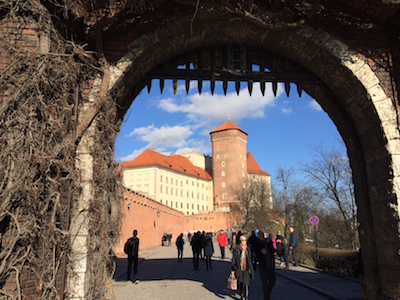Those UNESCO people really know what they’re talking about. After observing that so many of the places we have been visiting—and loving—lately (Split, Dubrovnik, Kotor) were listed as World Heritage Sites, we figure we should be paying attention to that designation. We might actually start going out of our way to see places on our list. Thank you, UNESCO people!
For future reference, here is a link to the World Heritage Site website (a site-site, or for the technically and/or linguistically nitpicky, a metasite): http://whc.unesco.org/en/list/
You might have inferred so far into this blog, given the title, that Krakow, Poland is the latest UNESCO World Heritage Site that we’ve visited. In the words of John Lithgow’s Dick Solomon, Ding, ding, ding, you are correct!1. Krakow (properly written Kraków and actually pronounced CROCK-oof) is Poland’s second largest city (behind Warsaw). The city dates from the 7th century, and as it is located with logistical perfection at an east-west, north-south cross roads, it was a thriving medieval trading town. For several centuries all roads in Central Europe literally ran through Krakow, and the locals exacted mandatory taxes and trading in everything from tin and coal to cloth and jewelry. Krakow was one of the most important cities in Europe for a very long time, and from 1038 to 1568 was the capital of Poland and the seat of the Polish monarchy.
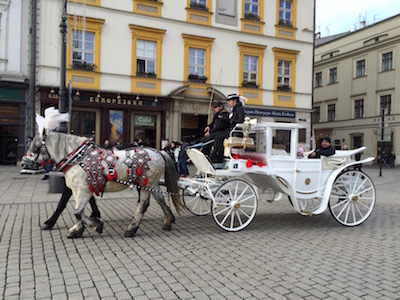
Krakow is the top place to visit in Poland (my apologies to Warsaw, Gdansk, and the expansive Polish countryside, all also very fine places to visit). For Catholics, Saint Pope John Paul II was born nearby and was bishop of Krakow before he left for Rome; there is no shortage of pride on display for their favorite Papa in Krakow, and there are plenty of pilgrimage sites to see (though we were a bit disappointed with the John Paul II museum at the Wawel Cathedral). Within tour bus distance nearby are two of the top destinations in Poland: Auschwitz-Birchenau and the Wieliczka Salt Mines, both topics of upcoming blogs.
Krakow itself, however, is a compact, formerly-walled medieval city. Remnants of the wall can still be seen protecting the city, particularly from the moat-now-park (the Planty) that circles the entire city. Get a place to stay in the old town (“Stare Miasta”) or just across the Planty park. There’s no need to learn the transit system: every corner of the old town will be within a 15 minute walk, except perhaps one site we mention below.
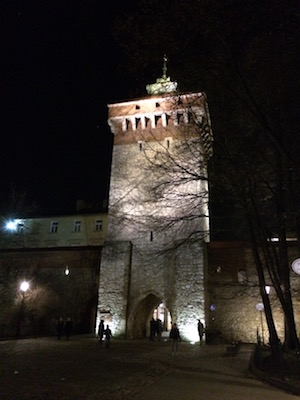
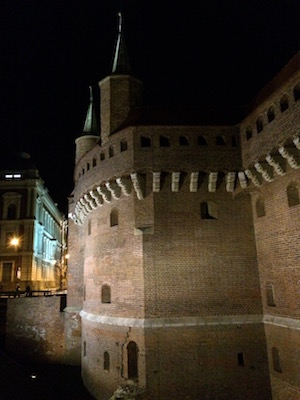
Here are the best things to see in Krakow…
Town Square (Rynek Glówny), Cloth Market, and Underground Museum – this is one of the grandest squares in all of Europe, and smack dab in the middle of it is a grand market building known as the Cloth Market (photo at top of this blog). Centuries ago this is where Krakovians taxed goods in transit and forced merchants to trade. Now you can purchase souvenirs and amber jewelry a-plenty. If you like historical sites and museums, don’t miss the Rynek Underground Museum, an expansive archaeological-dig-turned-museum beneath the square (where Chuck admired the medieval knife collection and Lori ogled the medieval shoe collection); get tickets in the center of the west side of the Cloth Market building facing the square.
Basilica of St. Mary – This is the huge church facing the square at an angle from the east. It’s “just” a parish church, not the cathedral (that’s next in our list). You can pay to tour (about $5) by buying a ticket across from the church’s right side, or if you attend a service it’s free (other than the collection plate). It’s a grand, though dark, church with an impressive altarpiece. But for (perhaps) the best part, you don’t even have to enter the church: at the top of the hour, a trumpeter opens a little window high up in the tower facing the square, and plays a tune. The song is abruptly cut short on purpose: as the legend goes, the trumpeter was once shot through the throat by an arrow during an attack on the city, so now the song is…abbreviated.
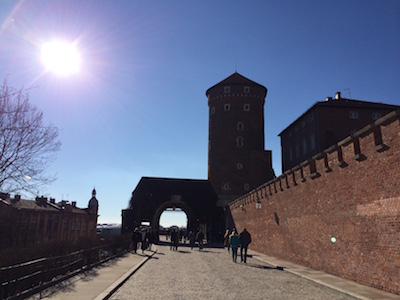
Wawel Cathedral, Palace, and Complex – The south end of the city, sort of the “mouth” of Krakow’s Stare Miasta, is a hill. On that hill is the Wawel Palace and Cathedral complex. You can walk up the ramps on the north or south side of the hill and around the complex for free views of the Vistula River. For about $20 you can buy a combo ticket to tour the Cathedral and its royal crypt, including a fun climb up the bell tower; the combo ticket also includes access to a John Paul II museum, but it’s only two rooms without much to see. You can also tour the Wawel Palace, which Euro-guru Rick Steves describes as, “Precious to Poles”, but otherwise without splendor. The cathedral itself is interesting and can be toured without a ticket, but your access is limited (pretty much) to the nave.
Schindler’s Factory and Museum – A 20 to 30 minute walk from Krakow’s old town, this museum is 99% a museum on the Nazi occupation of Krakow and 1% Schindler’s factory. It is probably one of the best World War II museums in all of Europe, but if you’re going because you’re a fan of the movie, you’ll be disappointed.
Krakow Itself – Krakow is one of those cities, like Amsterdam and Bruges and Venice, that is a site all by itself. The old town is charmingly packed with cobbled streets, old buildings, inexpensive pierogi houses and “milk bars” (cafeterias), and churches. The composer Chopin is a favorite son here, and you can find concerts of his music most nights. We attended a wonderful Mozart-Strauss-Bach concert at the church of St Peter and Paul, where nightly concerts are given, but it was colder in the church that night than it was outside. Krakow is also a bit of a party town, with no shortage of bars and pubs that come to life late and stay open to the wee hours of the morning. So explore by day, enjoy cheap Polish beer all night.
Footnotes
1 – Strictly speaking, Dick was not human. He was an alien. But the point remains: Krakow is a UNESCO World Heritage Site.
